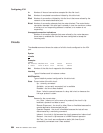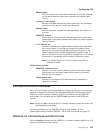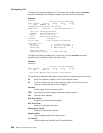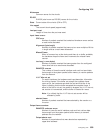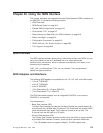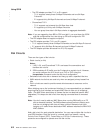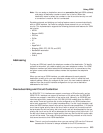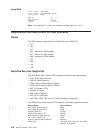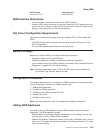– The PRI adapter provides T1/J1 or E1 support.
- T1/J1 supports twenty-three 64-Kbps B-channels and one 64-Kbps
D-channel.
- E1 supports thirty 64-Kbps B-channels and one 64-Kbps D-channel.
– Channelized T1/E1
- T1/J1 supports up to twenty-four 64-Kbps time slots.
- E1 supports up to thirty-one 64-Kbps time slots.
- You can group time slots in 64-Kbps chunks to aggregate bandwidth.
Note: If you are upgrading from BRI to PRI from talk 6, you must clear the ISDN
and dial configurations first, then bring up PRI and configure for PRI.
v The PRI adapter does not support multipoint.
v The PRI adapter provides T1/J1 and E1 support.
– T1/J1 supports twenty-three 64-Kbps B-channels and one 64-Kbps D-channel.
– E1 supports thirty 64-Kbps B-channels and one 64-Kbps D-channel.
v The PRI adapter provides enhanced line ID (LID) support.
Dial Circuits
There are four types of dial circuits:
v Static circuits (or link)
Notes:
1. I.430, I.431, and Channelized T1/E1 are leased line connections and
therefore do not dial.
2. ISDN considers X.25 traffic over the D-channel as a static circuit. However,
you could configure the X.25 circuit as a PVC or SVC using the
encapsulator command under the dial circuit configuration.
v Switched circuits that dial on demand and hang up after a specified idle time
v WAN restoral circuits that are used only when an assigned primary leased line
fails
v Dial-in circuits are used to provide remote clients access to resources on the
network.
When bridging over a dial on demand interface it is recommended that you disable
spanning tree for that interface and create MAC filters to filter out all undesired
traffic. (The MAC filters would drop all frames that are not destined specific MAC
addresses.) This keeps the dial circuit from staying connected due to unwanted
traffic.
Note: You don’t need to add any MAC filters when running BAN traffic on a FR
dial-on-demand interface. The BAN software always performs filtering such
that the only bridging traffic that will keep a dial-on-demand circuit from
hanging up is traffic whose destination MAC address matches the BAN DLCI
MAC address.
Add a dial circuit for each potential destination. You can map multiple dial circuits to
one ISDN interface. Each dial circuit is a normal serial line network, running
Point-to-Point Protocol (PPP), Frame Relay or X.25 (for D-channels only). These
protocols are configured to operate over the dial circuits.
Using ISDN
612
MRS V3.2 Software User’s Guide
|
|
|
|
|
|
|



